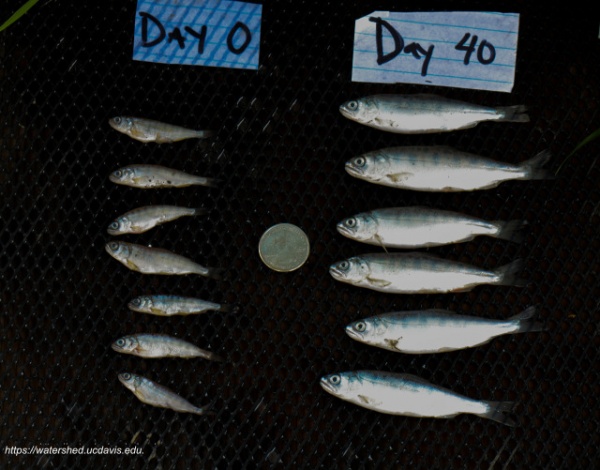 A recent article in the LA Times asked: can rice fields help endangered salmon in the Central Valley? Because that article really did not answer the question, I thought I would try in this post. The answer is: absolutely.
A recent article in the LA Times asked: can rice fields help endangered salmon in the Central Valley? Because that article really did not answer the question, I thought I would try in this post. The answer is: absolutely.
A significant portion of the endangered winter-run and spring-run salmon populations are now made up of hatchery fish. Hatchery fish are important in keeping the populations from falling further toward extinction and in helping toward recovery. To make the hatchery tool in the tool-box of recovery more effective, it is essential that a greater percentage of hatchery eggs become smolts that reach the ocean. Studies show that hatchery smolts released at or near hatcheries have a very poor survival rate to the Golden Gate. Trucking the hatchery smolts to the Bay increases survival, but results in significant straying to other Valley rivers.

Rice-field-reared salmon. Source: UC Davis photo
One way to increase smolt production and survival is to rear a portion of the newly hatched fry in Valley floodplain rice fields closer to the Bay. There have been plenty of experiments that show fall-run hatchery fry do well in terms of growth and survival in rice fields. The next step is putting that knowledge into management action. At a minimum, rearing a portion of newly hatched fry from hatcheries in natural floodplains is more “natural” than rearing them in hatchery raceways.
Winter-Run Salmon: Winter-run fry from the Livingston Stone federal hatchery could rear in the rice fields of the upper Yolo Bypass during late fall and early winter. Conditions would be ideal for growth and survival. Even in drought years, water would be available from the Colusa Basin Drain, whose water source is primarily the upper Sacramento River. As proven last year, managers could explicitly divert water for this purpose from near Red Bluff on the Sacramento River, through the Colusa Basin to the upper Yolo Bypass rice fields, and finally to the Tule Canal. This would facilitate emigration of the smolts produced to the Bay. The planned Fremont Weir “fix” will provide Sacramento River water directly to the Yolo Bypass within several years. The alteration of Fremont Weir will also provide passage back to the Sacramento River for any adult winter-run that are attracted to Yolo Bypass flows.
Spring-Run Salmon: Spring-run fry from the Feather River state hatchery could rear in rice fields in the lower Sutter Bypass adjacent to the lower Feather River. Rearing would occur in winter, when conditions would be ideal. A late winter flow pulse could facilitate the emigration of these fish (as well as wild fish) out of the Feather River to and through the Delta, and to the Bay and ocean.
What ifs:
- What about predators? Rice-field-reared winter-run smolts will have 100 miles less migration through the upper Sacramento River gauntlet of predators. Feather River rice-field smolts will be able to pass almost directly into the lower Sacramento River, thereby avoiding many miles of predator habitat in the lower Feather River. Yolo Bypass winter-run smolts would pass through 40 miles of the Tule Canal to reach Cache Slough in the Delta. Added flow and colder mid-winter water temperatures should minimize this real risk. Remember also that rice field habitat is seasonal. Bass and other species that dine on juvenile salmon don’t establish themselves in rice fields like they do in waters that are inundated year-round.
- How will the progress of these fish be measured? Like all other hatchery fish, these fish should all be coded-wire tagged, and a small portion should be radio-tagged, prior to release.
- What about straying? Rearing in the appropriate source water should help to minimize straying. Providing flow pulses during emigration will help in imprinting. Imprinting newly hatched fry at the hatcheries will also help.
- What about contribution to the population, especially given potentially low Delta survival in dry years? If necessary, the rice-field-produced smolts could be readily transported by barge from nearby Verona on the Sacramento River. They could also be released directly to the nearby Sacramento River or trucked to the Bay. In any event, the rice-field-reared smolts should reach the ocean about a month earlier and at a larger size than their hatchery-reared counterparts, which should lead to a marked survival advantage.
- What if such a program is too successful? This would be a great problem to have, for once. Too many hatchery fish could jeopardize the genetic viability of the population. If that becomes a problem, such a program (or the overall hatchery program) could be scaled back. But until we reach that day, floodplain rearing of hatchery fry is a more natural and more effective tool for the recovery toolbox than more conventional hatchery practices.
- What about landowners? Many rice field land owners and managers are fully supportive and are committed to implementing such a program.
- What about stakeholders and resource agencies? Such a program has yet to be implemented on a large scale to test if it can meet its objectives. There is a natural reluctance on the part of agencies to commit endangered salmon resources to something unproven like this. Pilot studies to date have proven the concept is viable. An appropriate next step is a large-scale contribution study involving several hundred thousand or more fry, in sufficient number to assess potential contribution to the population.
